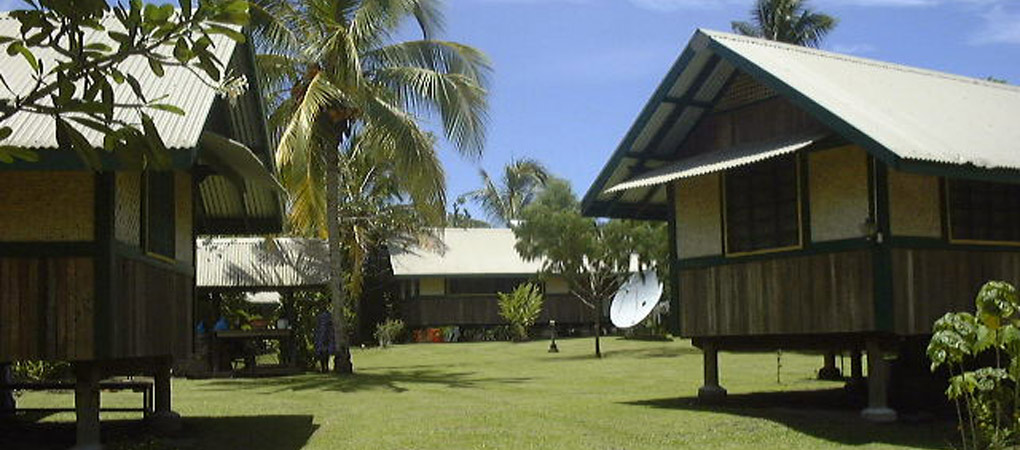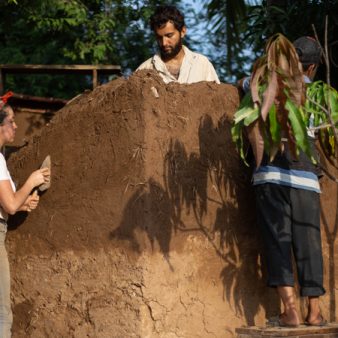Traditional design and construction systems have been adapted to meet modern housing needs in Papua New Guinea. Sustainably sourced timber is used throughout the project and the emphasis is upon affordability, durability and local income generation opportunities. Residents are involved as key participants in the development process. This approach has also been used for schools and other community buildings in the area.
Project Description
Aims and Objectives
The aim of the project is to develop a new and constantly evolving form of housing for Papua New Guinea (PNG) which:
- maintains and extends the knowledge inherent in PNG’s fine traditional architecture;
- provides for ongoing involvement of users in shaping house design;
- maximises local economic benefits by maximising use of local human and material resources in housing production;
- is easily taught, learned and replicated;
- is competitive with imported form of housing;
- is climatically, culturally, economically, and ecologically appropriate and sustainable.
Papua New Guinea is located in the Pacific Ocean and with a population of 5 million has a population density of 10 people per km2. Its GNP per capita is $800 and life expectancy is 58 years. 17 per cent of the population live in urban areas. Illiteracy rates range from 29 per cent for men to 45 per cent for women.
Although PNG possesses a rich traditional building heritage suited to the local material base, climate, skills base, economy and way of life, this is increasingly being supplanted by an imported modern architecture that is alien to the local way of life. It is also often very expensive and easily prone to rapid deterioration due to poor design and inappropriate materials. The Assai practice is dedicated to developing forms of architecture that draw upon local knowledge and traditions and are adapted to the local community and economy. The modernisation approach is strongly promoted by both the central government and the mechanisms of the market. The vast majority of housing in PNG is rural housing on traditional land. Other housing types are government housing for teachers etc, urban squatter settlements and private housing. In general, both housing finance and land are very difficult to obtain.
The Improved Traditional Housing Systems project consists of 300 individual projects that have been developed over the last 25 years throughout the islands and mainland of PNG. Of these, 82 are housing projects and the others are health or community buildings. The total number of houses built under this project is 312. Of these 70 are village or smallholder houses, 224 are rural or urban government houses for low wage earners and 18 are private houses for high and low income households. The high-income houses are useful in increasing the status of traditional design with lower income earners.
The approach used by Assai has been to analyse traditional PNG architecture, to understand and maintain its value and change it only where it is necessary to respond to new demands for mosquito proofing, cleanliness, electricity, water, sanitation, privacy and the car. For example, it is known that the traditional house has steep roofs and low eaves which shed the rain well, protect the walls and provide a large cool air volume inside. Traditional roofs however are made of thatch that is flammable, expensive to build and houses vermin. They are unsuitable for water collection. Iron roofs have been used to overcome the problems of thatch but the original roof shape and design has been retained. Single lined wall frames with a latticed infilling allow an increased amount of light into the house, where it is needed to carry out activities such as school homework.
Each housing project is designed with extensive end user consultation through a workshop process. Workshops are first held at the ‘pattern’ level, i.e. looking at what in general a house in this area should be like and secondly with the residents as part of the detailed design process. Natural materials and designs are appropriate for the climatic conditions and produce a healthy living environment compared to the air-conditioned houses that are built otherwise. Traditional building skills are retained and enhanced through the building process and through general confidence and capacity building.
The Assai philosophy is to preserve and adapt the traditional building culture in the face of modernisation and inappropriate western housing models. All houses are constructed using timber from sustainable forests in PNG, and in some cases have been built using timber from the village-level sawmill. Typical products used are adzed hardwood posts, sand and gravel excavated from river beds, small scale saw-milling, treated saplings, treated roofing shales and treated woven mats from sago, bamboo and cane. All houses are small and therefore inherently use fewer resources. The average house size is 50 – 90 m2.
The costs of the project vary since the programme consists of over 82 housing projects developed over a period of 25 years. On average a low-income house, fully serviced, costs $300/m2 and the higher income house costs $400/m2. In rural schemes where there is more labour provided by the family these are nearer to $150/m2. The conventional imported model costs $500-600/m2.
A range of income sources are used to fund the various projects that Assai are commissioned to carry out. These include private sector funds as well as national and international subsidy.
Why is it innovative?
- Use of traditional architecture as a prime driver for design and construction.
- Focus on developing a sustainable and appropriate language of design and system of construction.
- Emphasis upon affordability, durability and build-ability.
- Involvement of residents as key participants in the development process.
- Adoption of an open and inclusive philosophy towards knowledge exchange and intellectual property.
What is the environmental impact?
The houses are naturally cool since they use the traditional architecture design principles. Air conditioning is therefore not needed and this represents the biggest consumer of energy in PNG. The houses incorporate environmental technologies such as dry composing toilet units and solar power. Most of the houses use water collected from the roof. Sustainably sourced timber is used throughout. Bamboo and rattan are also widely used for finishings.
Is it financially sustainable?
Costs are lower than imported housing ($150-300/m2 compared to $600/m2 for conventional imported houses). In rural areas people contribute materials towards the housing. In other projects they contribute labour under a lead carpenter contracted for the job.
What is the social impact?
The project is implemented in way that is climatically, culturally, economically, and ecologically appropriate and sustainable and where residents play an active role in the process.
Transfer
An open space approach is used to intellectual property so that the designs are made widely available for people to adapt and use.
Partnership
Private sector, national government, local community



